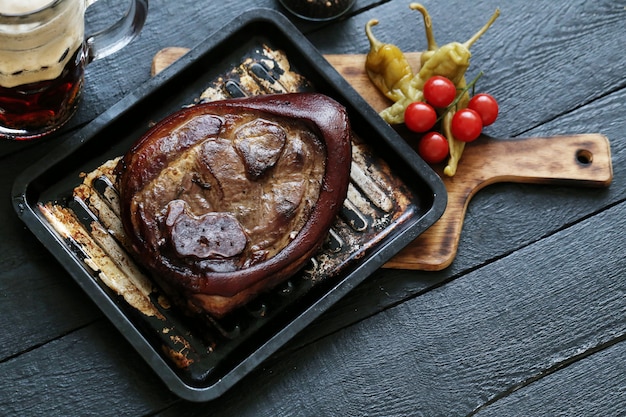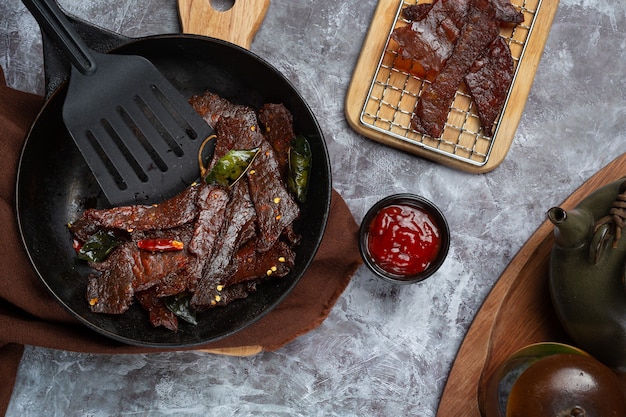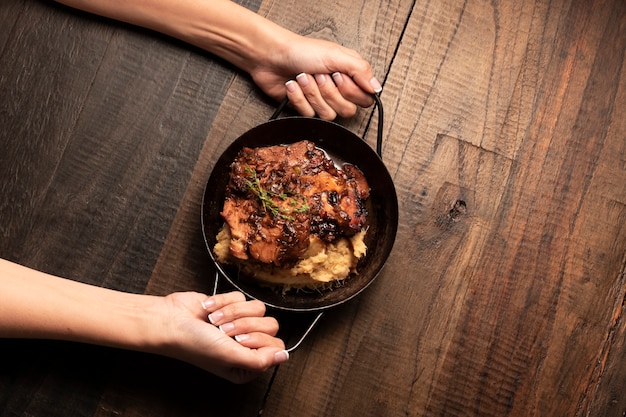There’s a certain magic in slow cooking. It’s like alchemy, transforming humble ingredients into something truly special. And when it comes to slow cooker recipes, beef brisket reigns supreme. This tough cut of meat, when cooked low and slow, melts in your mouth with an unbelievable tenderness that’s almost impossible to achieve any other way. It’s a culinary triumph that leaves you feeling like a master chef, even if you’re a total beginner.
Over the years, I've tackled countless brisket recipes, experimenting, tweaking, and perfecting until I finally landed on the ultimate guide to slow cooker beef brisket perfection. From choosing the right cut to achieving that irresistible bark and those lusciously tender shreds, this guide will unravel the secrets to crafting a brisket that'll have everyone begging for seconds. So, put on your chef's hat, grab your slow cooker, and let's embark on this delicious journey together.
Part 1: Choosing Your Brisket

The Anatomy of a Brisket
Before we dive into the details, let’s understand what a brisket is. This cut comes from the chest of a cow, a part that’s naturally quite tough and lean. But don't let that deter you. The low and slow cooking method of slow cookers is the key to unlocking its tenderness and unveiling its hidden flavor potential. There are two main types of brisket:
- Point: The point is the thicker, fattier end of the brisket. It's known for its rich flavor, thanks to its higher marbling (those little streaks of fat). If you love a good dose of fat and richness, the point is your go-to. However, it can be a bit trickier to cook evenly due to its uneven thickness.
- Flat: The flat is the leaner and flatter end of the brisket. It has a more consistent texture, making it great for those who prefer a less fatty cut. However, it can be a bit drier compared to the point.
Personally, I love the richness of the point for its incredible flavor. It's a true testament to the magic of fat rendering down and infusing the meat with its decadent essence. But if you're looking for a leaner, more consistent cut, the flat is a solid choice. For maximum versatility, you can also get a "whole packer" brisket, which combines both the point and flat, offering a blend of richness and consistency.
The Art of Selecting a perfect brisket
Picking the right brisket is like choosing the perfect ingredient for a masterpiece. Here's what to look for at the butcher counter:
- Marbling: The more marbling, the more flavor and juiciness you can expect. Look for a brisket with a good balance of marbling throughout, not just in patches.
- Color: A good brisket should have a vibrant, reddish-pink color. Avoid anything that looks discolored, dull, or pale.
- Texture: When you press on a good brisket, it should feel firm and springy, like a well-toned muscle. Avoid anything that feels soft or mushy, as this could indicate poor quality or poor storage.
- Trim: Some butchers will have already trimmed the brisket for you. If they haven't, be sure to trim off any excess fat or silver skin. This tough, silvery membrane can make the meat tough and chewy, so removing it is essential for achieving a tender outcome.
Part 2: Preparing Your Brisket for Slow Cooker Glory

Seasoning with Simplicity (and Flavor!)
When it comes to seasoning a brisket, I like to keep things simple. Salt and pepper are the backbone of any great brisket, but I often add a touch of garlic powder and onion powder for an extra layer of depth. You can definitely experiment with different spice rubs, but remember, less is more when it comes to brisket seasoning. You don't want to overpower the natural, inherent flavor of the meat.
Trimming the Fat and Conquering the Silver Skin
Before you start seasoning, take a few minutes to trim off any excess fat. Most butchers will have already done a good job, but a quick once-over is always a good idea. You want to leave a thin layer of fat on top, as this will render down during cooking and keep the meat moist and flavorful.
Next, tackle the silver skin. This tough, silvery membrane runs along the brisket and can make the meat tough and chewy. Removing it is crucial for achieving tender, melt-in-your-mouth results.
To remove the silver skin, you'll need a sharp knife. Start at the thickest part of the brisket and gently slide the knife under the skin. Carefully work your way along the entire surface, lifting the skin off. Don’t worry if the skin tears; just remove it as best as you can. The goal is to remove as much of the silver skin as possible.
Rubbing it In for Maximum Flavor
Once your brisket is trimmed, it’s time to season. Pat the brisket dry with paper towels to remove any excess moisture. This ensures that your seasoning adheres evenly and doesn’t get washed away during cooking. Then, rub your chosen seasoning all over the surface, making sure to get into every nook and cranny. I like to press the seasoning into the meat so it sticks well and infuses the brisket with its flavor during the long, slow cooking process.
Part 3: Slow Cooker Setup – The Key to Brisket Perfection

Choosing the Right Slow Cooker for the Job
When it comes to slow cooker brisket, size matters. I have two slow cookers: a 6-quart and an 8-quart. For brisket, I always choose the 8-quart option. But don't worry if you don't have a super large slow cooker; a smaller one will work just fine. Just make sure your brisket fits comfortably inside and has enough room to cook evenly.
Creating a Moist and Flavorful Environment for Your Brisket
The key to slow cooker brisket is maintaining a moist cooking environment. This ensures that the meat stays tender and juicy throughout the long cooking process. There are a couple of ways to achieve this. Some people add liquid directly to the bottom of the slow cooker, like broth or water. But I prefer to create a flavorful bed for my brisket, using a mixture of chopped onions, carrots, and celery. This adds a fantastic depth of flavor to the finished dish, infusing the brisket with aromas and enriching its taste.
Low and Slow – The Secret to Brisket Tenderness
Now, it’s time to pop your seasoned brisket into the slow cooker. Make sure to place the brisket fat side up. This helps the fat to render down, keeping the meat moist and tender. You can also add a few cups of liquid to the bottom of the slow cooker to help maintain moisture. I usually opt for beef broth, but you can use water or even apple juice for a slightly sweeter flavor.
Cover the slow cooker and cook on low for 8-10 hours. The exact cooking time will depend on the size and thickness of your brisket. Check it halfway through the cooking time to make sure it's progressing nicely and adjust the cooking time if needed.
One important tip: don’t open the lid too often. Every time you open it, you release heat and moisture, which can slow down the cooking process and potentially dry out the brisket. So be patient and resist the temptation to peek too often.
Part 4: Checking for Doneness – A Meat Lover's Must-Do
The Fork Test – A Foolproof Way to Know When Your Brisket is Ready
As your brisket simmers away, you’ll start to anticipate the moment of truth: knowing when it’s perfectly cooked. Around the 8-hour mark, it's time to start checking the brisket for doneness. I like to use the "fork test". Simply insert a fork into the thickest part of the brisket. If it goes in easily, with minimal resistance, and the meat feels tender, your brisket is ready.
What if Your Brisket Isn't Quite Ready?
If the brisket isn't tender yet, don’t worry! You can keep cooking it for another hour or two. Just make sure to check on it every 30 minutes to avoid overcooking. If you're ever unsure, you can always use a meat thermometer to check the internal temperature. The brisket should reach an internal temperature of 190-200°F (93-93°C).
Part 5: Resting and Shredding – The Finishing Touches
The Importance of Resting
After the long slow cook, your brisket needs a little break. Resting is crucial for allowing the juices to redistribute throughout the meat, making it even more tender and juicy. I usually let my brisket rest for at least 30 minutes, wrapped in foil to keep it warm and prevent it from drying out.
Shredding - Unlocking the Tenderness of Your Brisket
The moment you've been waiting for is here: shredding time! After your brisket has rested, it's time to unlock its tender, melt-in-your-mouth potential. This is where the slow cooker magic truly comes to life. The meat should fall apart easily when you shred it with two forks. You can also use your fingers to pull the meat apart, savoring its incredible texture and aroma.
Part 6: The Bark – A Brisket's Crown Jewel
Let's talk about that delicious crust that forms on the brisket during the slow cooking process. It's called the bark, and it's a true testament to the magic of low and slow cooking. This mix of browned meat and caramelized seasonings adds an incredible depth of flavor, enhancing the already delicious brisket.
Achieving the Perfect Bark
To get a good bark, it’s important to let the brisket cook uncovered for the last hour or two of cooking. This allows the surface to dry out and brown, creating that irresistible crust. If you like a really crispy bark, you can even broil the brisket for a few minutes at the end of cooking, but be careful not to burn it.
Part 7: Serving and Storing Leftovers – Making the Most of Your Brisket
How to Serve Up a Brisket Feast
Slow cooker beef brisket is a culinary chameleon. You can serve it on its own, or use it in a variety of dishes, making it a true crowd-pleaser. Here are a few ideas to inspire your next brisket masterpiece:
- Sandwiches: Brisket sandwiches are a classic for a reason. Pile shredded brisket on a bun with your favorite toppings like coleslaw, pickles, and barbecue sauce. The tenderness of the meat and the tangy flavors of the toppings create a perfect harmony.
- Tacos: Brisket tacos are a delicious and easy way to use up leftovers. Just warm up the shredded brisket and serve it in tortillas with your favorite toppings like salsa, guacamole, and sour cream. It's a tasty and satisfying way to enjoy brisket for lunch or dinner.
- Nachos: Add shredded brisket to your next batch of nachos for an extra layer of flavor and texture. It adds a touch of meaty goodness to this classic snack.
- Soup: Brisket adds a rich and hearty flavor to soups and stews. Its deep, savory taste complements the other ingredients and creates a comforting, warming meal.
You can also serve the brisket on a platter, sliced thinly and drizzled with barbecue sauce. Or if you're feeling fancy, you can even serve it with mashed potatoes, gravy, and asparagus for a more elegant presentation.
Making the Most of Leftover Brisket – A Gift That Keeps on Giving
Leftover brisket is a true gift. I love to store it in the fridge for up to 4 days. You can reheat it in the microwave or oven, but I find that it tastes best when it’s warmed up in a skillet on the stovetop. This allows the flavors to meld and reheat evenly, preserving the brisket's tenderness.
You can also freeze leftover brisket for up to 3 months. Just make sure to wrap it tightly in plastic wrap and aluminum foil before freezing. To reheat frozen brisket, thaw it in the refrigerator overnight and then reheat it as you would fresh brisket.
Part 8: Tips for Success – Avoiding Common Mistakes
Over the years, I've made my fair share of brisket mistakes. But through trial and error, I've learned a few key things to avoid:
- Don't overcook it: Brisket is a delicate cut of meat. It's easy to overcook it and make it tough and dry. If you're not sure if it's done, err on the side of caution and cook it for a shorter time.
- Don't open the lid too often: Every time you open the lid, you release heat and moisture. This can slow down the cooking process and make the brisket dry. Be patient and let it cook undisturbed.
- Don't be afraid to experiment: Brisket is a blank canvas for flavor. Don't be afraid to try different rubs and sauces. Explore your culinary creativity and discover new flavors that you love.
Part 9: Mastering the Sauce – The Finishing Touch
The Sauce – A Symphony of Flavor
The sauce can really make or break your brisket. It's like a symphony, adding a final flourish to a delicious masterpiece. I've experimented with countless recipes, but here's a simple yet flavorful method that consistently delivers:
A Simple Yet Flavorful barbecue sauce recipe
Ingredients:
- 1 cup ketchup
- 1/2 cup apple cider vinegar
- 1/4 cup brown sugar
- 2 tablespoons Worcestershire sauce
- 1 tablespoon Dijon mustard
- 1 teaspoon smoked paprika
- 1/2 teaspoon garlic powder
- 1/4 teaspoon onion powder
- Salt and pepper to taste
Instructions:
- Combine all ingredients in a saucepan over medium heat.
- Bring to a simmer and cook for 5-10 minutes, stirring occasionally, until the sauce has thickened.
- Remove from the heat and let cool slightly before serving.
This sauce is a perfect blend of sweet, tangy, and smoky flavors that complement the brisket beautifully.
Part 10: FAQs – Your Brisket Questions Answered
Here are some common questions about slow cooker beef brisket:
1. Can I use a frozen brisket?
Yes, you can use a frozen brisket, but you'll need to thaw it completely before cooking. I recommend thawing the brisket in the refrigerator overnight. This ensures that it thaws evenly and prevents the meat from becoming damaged. You can also thaw it in a cold water bath, but make sure to change the water every 30 minutes to keep it cold and safe for consumption.
2. How long can I store cooked brisket in the fridge?
Cooked brisket can be stored in the refrigerator for up to 4 days. Just make sure to wrap it tightly in plastic wrap or aluminum foil to prevent it from drying out and absorbing other flavors in the refrigerator.
3. Can I cook brisket in a slow cooker on high?
You can cook brisket on high, but it will take a shorter amount of time. I recommend cooking on low for 8-10 hours for the best results. If you cook on high, check the brisket more frequently to make sure it doesn't overcook and become tough or dry.
4. What if my brisket is too salty?
If you think your brisket is too salty, you can try adding a bit of sugar or honey to the sauce to balance out the saltiness. You can also add a little bit of water to the sauce to dilute the saltiness.
5. Can I cook other meats in the slow cooker?
Absolutely! Slow cookers are great for cooking a variety of meats, including chicken, pork, and lamb. Just adjust the cooking time accordingly, and remember to always check the meat's internal temperature to ensure it's cooked to a safe temperature.
There you have it! My complete guide to slow cooker beef brisket perfection. With a bit of patience and these tips, you'll be able to create melt-in-your-mouth brisket that will have everyone asking for seconds.
And remember, the best brisket is the one you make with love. So, relax, have fun, and enjoy the process!
Everyone is watching

Prime Rib Roast Cooking Time Chart: Per Pound Guide
Cooking TipsPrime rib roast. Just the name conjures images of lavish dinners, crackling fires, and hearty laughter. It’s ...

How Long to Bake Potatoes in the Oven (Perfect Every Time)
Cooking TipsBaked potatoes are a staple in my kitchen. They're incredibly versatile, delicious, and surprisingly easy to m...

Perfect Rice Every Time: The Ultimate Guide to Cooking Rice
Cooking TipsAs a self-proclaimed foodie, I've always been a bit obsessed with rice. It's the foundation of countless cuisi...

The Ultimate Guide to Cooking Asparagus: Tips, Techniques, and Recipes
Cooking TipsAsparagus. The mere mention of this spring delicacy conjures up images of vibrant green spears, crisp and burs...

Ultimate Guide to Cooking the Perfect Thanksgiving Turkey
Cooking TipsThanksgiving. Just the word conjures up images of overflowing tables laden with delicious food, the scent of r...
